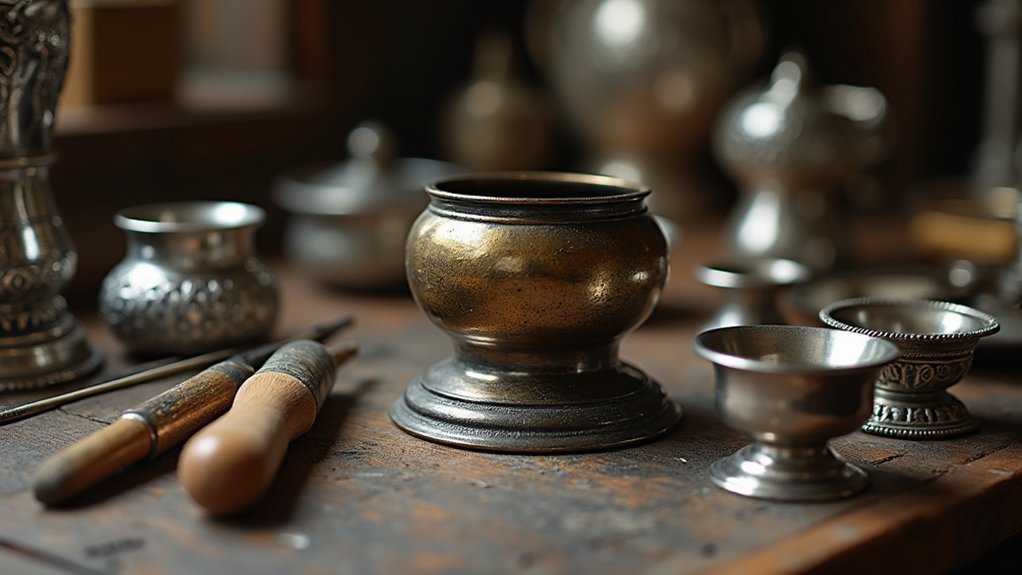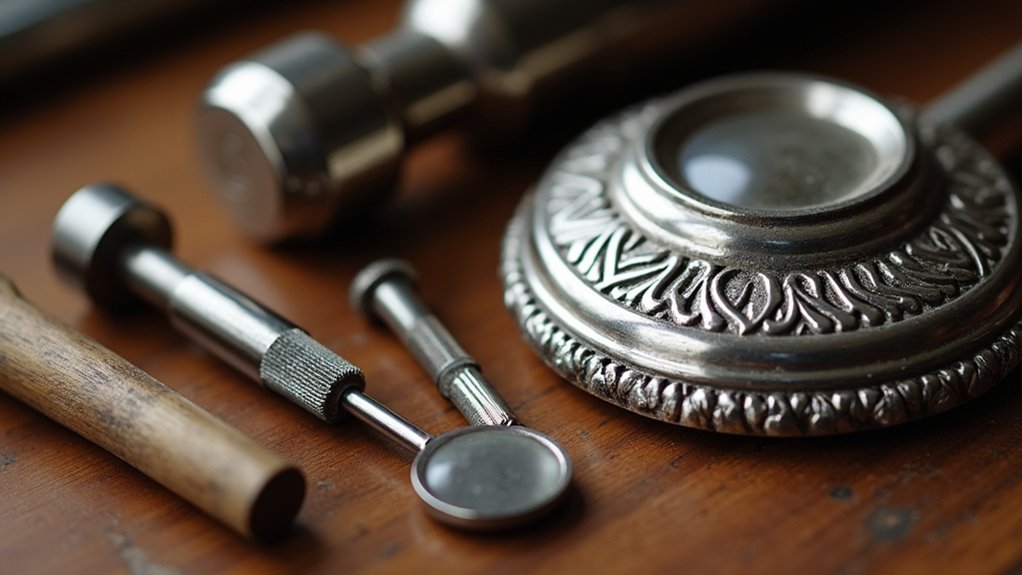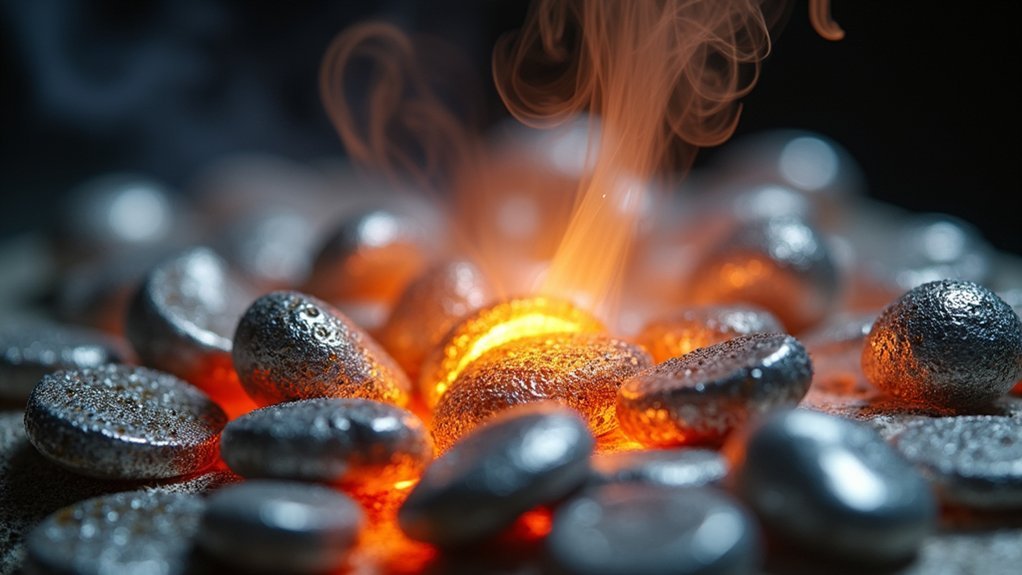You can master ancient metalworking by starting with essential hand tools like hammers, tongs, and an anvil, then learning proper material selection between ferrous metals for strength and non-ferrous for decoration. Develop foundational hammering techniques through controlled wrist action and precise strikes while managing forge temperatures between 1,500°F-2,000°F using color recognition from dull red to cherry-red. Practice joining methods like soldering and riveting, then apply finishing techniques including polishing and patination to create authentic historical pieces that’ll connect you with 10,000 years of metalworking tradition.
Understanding Ancient Metalworking Traditions and Cultural Heritage

When you examine ancient metalworking traditions, you’re exploring one of humanity’s most transformative technological achievements that shaped civilizations for over 10,000 years. Dating back to 8,700 BCE in Iraq, these traditions established metal as essential to human progress.
You’ll discover that ancient techniques like soldering and welding still form blacksmithing foundations today.
Egyptian and Mesopotamian cultures demonstrate how metalwork transcended functionality, creating ornamental pieces that displayed power and status. As you study these cultural practices, you’ll notice artisans held prestigious positions, driving technological advancement within their communities.
Ancient metalworkers weren’t just craftsmen—they were prestigious artisans whose ornamental creations symbolized power and drove entire civilizations forward.
Their work blended artistic expression with practical design, influencing contemporary metal arts. Understanding this heritage connects you to generations of craftsmen who transformed raw materials into tools, weapons, and artistic treasures that defined civilizations.
Essential Tools and Equipment for Traditional Metal Crafting
You’ll need specific basic hand tools to begin your traditional metalworking journey, starting with a sturdy hammer for shaping metal and reliable tongs for safely gripping hot materials.
An anvil serves as your essential work surface, providing the solid foundation required for effective forging techniques.
Your forge becomes the heart of your workshop, whether it’s coal-fired, gas-powered, or electric, as it heats metal to the precise temperatures needed for manipulation and shaping.
Basic Hand Tools
Five fundamental hand tools form the backbone of traditional metalworking: hammers, tongs, chisels, files, and punches.
You’ll need different hammer types for specific tasks—ball-peen hammers excel at shaping curved surfaces, while cross-peen hammers create precise directional force. Choose hammer weights that match your project’s requirements.
Your tongs selection should include flat-nose and round-nose varieties. These allow you to securely grip and maneuver hot metal during forging without burning yourself. Quality tongs provide vital control over your workpiece.
Chisels cut and shape metal effectively when properly sharpened. Keep various sizes available for different cutting depths and angles.
Files serve pivotal smoothing functions, refining rough surfaces to achieve professional finishes. Stock coarse files for initial material removal and fine files for final surface preparation.
Forge and Fire
While hand tools shape and refine your metalwork, the forge serves as the heart of your workshop where raw metal transforms into malleable material.
You’ll need a reliable forge to heat steel to working temperatures, allowing you to manipulate metal using traditional techniques passed down through generations.
Essential blacksmithing tools include an anvil for shaping, various hammers for forging, and tongs for gripping hot steel safely.
Don’t overlook safety equipment—heat-resistant gloves, safety glasses, and a leather apron protect you from sparks and burns.
Your setup requires a quenching tank filled with water or oil for controlled cooling and hardening.
Add chisels for cutting, punches for holes, and files for finishing touches to complete your forge workshop.
Material Selection: Choosing the Right Metals for Historic Techniques

Three fundamental principles guide your metal selection for ancient techniques: compatibility, workability, and historical authenticity.
When selecting compatible metals, you’ll find copper and tin create bronze—a combination used since 3000 BCE that’s perfect for bronze casting in foundry applications. Consider each metal’s melting point carefully; bronze melts between 900-1,000°C, making it ideal for casting techniques.
Ferrous and non-ferrous metals serve different purposes in your material selection process. Iron and steel offer superior strength for tools and weapons, while gold and silver excel for decorative purposes in jewelry due to their corrosion resistance.
Historical context matters—pewter’s tin-lead alloy dominated medieval European utensil-making. Understanding these ancient metalworking techniques guarantees you’ll choose materials that honor traditional methods while achieving authentic results in your workshop projects.
Foundational Skills: Basic Hammering and Forming Methods
Once you’ve selected your metals, mastering hammer control becomes your gateway to authentic ancient metalworking.
You’ll need basic skills that form the foundation of all metalworking techniques. Start by developing a firm grip and using controlled wrist action for precise strikes. Practice repetitive hammering on flat surfaces to build muscle memory and consistency.
Essential forming methods include drawing out to lengthen metal, upsetting to thicken sections, and bending for shaping curves. Different hammer types—cross-peen and ball-peen—create varied textures and effects on your metal workpieces.
Safety remains vital throughout your practice. Always wear protective goggles and gloves when hammering.
These foundational techniques will prepare you for more advanced ancient metalworking methods while ensuring your projects maintain historical authenticity.
Advanced Joining Techniques: Soldering and Ancient Assembly Methods

After mastering basic hammering and forming, you’ll advance to sophisticated joining techniques that ancient metalworkers perfected centuries ago.
Soldering stands as one of history’s most refined metal assembly methods, requiring temperatures between 180°C to 450°C for delicate work.
Master these essential soldering principles:
- Surface preparation – Always start with a clean surface, removing all oxidation and impurities that prevent proper bonding.
- Flux application – Apply flux generously to eliminate remaining contaminants and guarantee strong solder adhesion.
- Heat control – Maintain consistent temperature using controlled soldering tools for precision work.
- Material selection – Choose appropriate tin-silver-copper alloys over traditional lead-based solders.
Ancient assembly methods like riveting and brazing complement soldering perfectly.
These advanced techniques create durable metal structures that withstand time, combining functionality with artistic expression in your metalworking projects.
Surface Decoration: Engraving, Chasing, and Repoussé Mastery
While soldering and assembly create the structural foundation of your metalwork, surface decoration transforms functional pieces into stunning artistic expressions.
You’ll master three essential techniques: engraving, chasing, and repoussé.
Engraving involves cutting intricate designs into metal surfaces using specialized gravers, creating detailed patterns on jewelry and decorative objects.
Chasing pushes metal from the front to form raised designs without removing material, adding depth and texture to your work.
Repoussé complements chasing by shaping metal from behind, producing pronounced three-dimensional relief effects.
Understanding metal properties is fundamental for achieving desired results.
Understanding how different metals respond to pressure, heat, and tooling determines the success of your decorative metalworking techniques.
These ancient surface decoration methods require practice with various tools and remain critical skills in contemporary metalworking for creating unique artistic expressions.
Fire Management and Temperature Control in Traditional Forging

You’ll need to master coal fire building as your foundation for successful traditional forging, starting with proper fuel selection and airflow management.
Once you’ve established a consistent fire, you must learn to read the metal’s color changes as your primary temperature gauge.
These visual cues will tell you exactly when your steel reaches the ideal forging heat without relying on modern instruments.
Coal Fire Building Basics
Since mastering fire control forms the foundation of all successful forging work, you’ll need to understand how to build and maintain a proper coal fire that responds to your metalworking needs.
These traditional forging techniques require precision and practice to achieve ideal temperatures for effective metalworking.
- Create a sturdy base with charcoal layers, then add coal and kindling to establish proper ignition and airflow patterns.
- Maintain temperatures between 1,500°F and 2,000°F by adjusting coal amounts and controlling air intake through your forge’s tuyere.
- Use hand-operated bellows to manage airflow effectively, enhancing combustion for better heat control in your blacksmithing techniques.
- Monitor fire color consistently and remove clinkers regularly to guarantee a clean forging environment that supports quality metalwork.
Heat Color Recognition
As metal heats in your forge, it transforms through a predictable spectrum of colors that serve as your primary temperature gauge in traditional blacksmithing.
Heat color recognition becomes your essential skill, guiding vital decisions throughout the forging process. Watch for dull red at 1,000°F, progressing to cherry-red when the metal’s ready for shaping, then bright yellow at 2,000°F.
Consistent heat management prevents common pitfalls in traditional forging. Overheating causes oxidation and scale formation, while insufficient heat makes metal brittle and unworkable.
Control your forge’s airflow to achieve precise temperature control—increased airflow raises heat, decreased airflow lowers it.
Master these blacksmithing techniques through deliberate practice. Real-time adjustments based on color recognition enhance your craftsmanship, ensuring superior results in every forged piece you create.
Pattern Development: Creating Authentic Historical Designs
Pattern development forms the artistic backbone of authentic historical metalwork, requiring you to immerse yourself in the visual language of ancient craftsmen.
You’ll master intricate designs by studying time-tested patterns like Mokume Gane’s raindrop and wood grain motifs that defined ancient cultures.
Follow this systematic approach:
- Analyze historical artifacts to identify authentic design elements and construction methods used by master craftsmen.
- Use traditional tools like chisels and hammers to replicate ancient forging techniques with precision.
- Experiment with metal combinations historically employed, ensuring your authenticity matches period-appropriate materials.
- Document everything through detailed sketches and photographs, mirroring ancient artisans’ meticulous record-keeping practices.
This methodical pattern development process connects you directly to centuries-old metalworking traditions while building your technical expertise.
Finishing Techniques: Polishing, Patination, and Preservation

While your metalwork piece may showcase perfect pattern development, it remains incomplete until you master the critical finishing techniques that transform raw forged metal into enduring art.
Start polishing with coarse abrasives, progressively moving to finer grits for an ideal surface finish. Remember that softer metals like brass need gentler treatment than harder stainless steel.
Once you’ve achieved the desired smoothness, consider patination to enhance color and texture while adding corrosion protection.
Apply preservation techniques through protective coatings like wax or oil to prevent oxidation and tarnishing. These barriers maintain your metalwork pieces’ aesthetic appeal over time.
Don’t overlook regular maintenance—consistently cleaning and reapplying protective layers guarantees your finished pieces retain their beauty and structural integrity for generations.
Workshop Projects: Creating Your First Ancient-Style Masterpiece
Now that you’ve perfected your finishing techniques, it’s time to put your skills into practice with your first ancient-style masterpiece.
Workshop projects let you create authentic pieces using traditional techniques that mirror ancient metalworking methods. Your blacksmithing forge and tools and equipment will help you forge connections to historical craftsmanship.
Here’s your project roadmap:
- Start Simple – Begin with basic jewelry or small tools to master fundamental hammering and metal casting techniques.
- Choose Historical Materials – Select copper or bronze that ancient artisans commonly used.
- Use Traditional Tools – Work with period-appropriate hammers, anvils, and molds for authentic experience.
- Document Everything – Record your process and compare results to historical artifacts for continuous improvement.
Each project deepens your understanding of ancient metalworking while building essential skills.
Frequently Asked Questions
Is Metalworking an Expensive Hobby?
Yes, you’ll find metalworking expensive initially. You’ll spend hundreds to thousands on tools like welders and anvils, plus materials and safety gear. However, you can reduce costs by buying used equipment and sourcing scrap materials.
How Hard Is It to Learn Metalworking?
You’ll find metalworking moderately challenging initially, but it’s definitely learnable. Start with basic techniques like soldering, take classes for proper guidance, and you’ll gradually master more complex skills through consistent practice and dedication.
What Are the Five Basic Metal Working Operations?
You’ll master five fundamental metalworking operations: cutting removes material through milling and drilling, forming reshapes without removal, joining connects pieces permanently, casting pours molten metal into molds, and finishing enhances appearance.
What Is Metal Work in Construction?
You’ll use metalworking in construction to fabricate and assemble steel or aluminum components for structural frameworks, supports, and reinforcements. You’ll employ welding, cutting, and forming techniques to create safe, durable building elements.
In Summary
You’ve now gained the essential knowledge to begin your ancient metalworking journey. Start with simple projects using basic tools and gradually work toward more complex techniques. Remember that mastering these traditional skills takes time and practice. Don’t rush the process—embrace each step as part of your craft development. Your dedication to preserving these ancient methods will create beautiful, authentic pieces while connecting you to centuries of metalworking heritage.





Leave a Reply